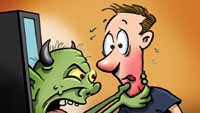3-D is stereo, so let's shoot it that way

Audiovisual media has evolved in steps since its inception a century ago. First, we had the phonograph and the silent movie. Next movies gained sound, which was followed by color. Then came television. Later, movie developments included widescreen pictures and multichannel sound, initially stereo and later surround. Television has since adopted these features.
The new buzz is about stereoscopic, or 3-D, video. Recently, I was reading about a new technology that turns regular 2-D content into 3-D, and I was overcome with déjà vu. Every time a new technology comes along, in its wake are conversion technologies that promise the earth.
For example, with audio, it was pseudo-stereo. I remember listening to old vinyl where crude bandpass filters apportioned monaural recordings across two speakers. The effect could best be described as a distortion.
With the visual media, this first happened with the colorization of monochrome movies. Snake oil salesmen sold color filters to tape to the CRT — blue at the top (the sky) and green at the bottom (the grass). The rest of the picture needed a vivid imagination.
With the launch of HD, the favorite kludge was to upconvert, preferably analog composite so that the MPEG encoder was presented with a mix of artifacts and noise.
Now that 3-D is on the horizon for television, the same flimflam is surfacing. Do you have old 2-D content? No problem. Run it through our box and abracadabra, you have 3-D. Where does this new information come from? The stereo stage, the colors, the depth information — once it's been thrown away, how can it be recovered?
Sure there are some clever algorithms out there, but do we need these technologies? If you want stereo, use more mics. For color, use a tripack emulsion or a three-sensor camera. The same applies to 3-D.
Get the TV Tech Newsletter
The professional video industry's #1 source for news, trends and product and tech information. Sign up below.
Quadraphonic sound is a good example of the failure that can occur during a potential step forward in audio perception. Twenty years later, we have surround sound, which has proven to be a success in the consumer marketplace. Stereoscopic visual systems have also encountered many false starts over the last 150 years or so.
The public will soon debunk the technologies that claim to derive missing information from archive content. They may not understand the underlying processes in our perception of the scene, but the false processes are destined to fail in delivering the ultimate in realism. When stereo comes to television, if you want to thrill the viewers, get out there with a stereo camera rig.
Pseudo-stereo, pseudo-3-D — let's not forget what pseudo means. Its root is the Greek word for false. If viewers watch HD, let's give them HD, not upconverts. Additionally, 5.1 should not be created from a stereophonic source, and 3-D TV, when and if it becomes a real service, should come from a stereoscopic source. It is very tempting for program buyers to save money and buy a legacy format and upconvert, but the discerning viewer cannot be conned.
Broadcast engineers strive to deliver the highest quality viewing experience that the format (and cost) permits. Archive content should be delivered in its original format, with the only processing being spatial scaling to suit the delivery channel. What do you think? Please e-mail me with your views (editor@broadcastengineeringworld.com).
Send comments to: editor@broadcastengineeringworld.com
